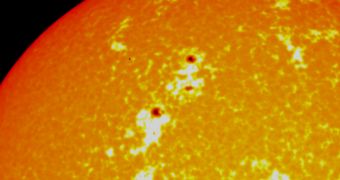In a recent paper, researchers show that several months of lag exist between the time when the Sun reaches the lowest level of activity in its 11-year cycle and the time when the star's magnetic effects start manifesting themselves on Earth.
This delay can sometimes span more than 8 months, investigators write in the May 16 issue of the esteemed scientific journal Annales Geophysicae. The conclusion belongs to a study conducted during the last solar cycle minimum, back in 2008.
At that time, the star displayed an activity level far below anything astronomers recorded since they began keeping track of solar activity professionally. Unofficially, amateur astronomers have kept track of sunspots and other solar events since 1611.
It's through these long-term observations that researchers finally realized that the Sun functions in 11-year-long cycles, which alternate periods of high activity – called solar maximums – with periods of low activity – called solar minimums.
The main difference between the two is the number of sunspots, coronal mass ejections, and other similar events that take place on the Sun's surface. However, not all cycles are the same. Some can be more energetic than others, solar physicists say.
But in 2008 experts noticed that the solar minimum was not accompanied by related magnetic effects immediately, but rather 8 months later. It was then that the Sun's lack of activity began influencing Earth's magnetosphere and its auroras.
Based on sunspot number, “2008 was identified as the period of solar minimum. But the geomagnetic effects on Earth reached their minimum quite some time later, in 2009. So we decided to look at what caused the geomagnetic minimum,” says Bruce Tsurutani.
The expert is a space weather scientist at the NASA Jet Propulsion Laboratory (JPL), in Pasadena, California, and also the first author of the new research paper.
During the research, experts learned that low interplanetary magnetic field strength, combined with slower solar wind speed and smaller magnetic fluctuations due to coronal hole placement were responsible for the 2008 readings.
“Working together, these three factors create the perfect environment for a geomagnetic minimum,” a JPL press release states.

 14 DAY TRIAL //
14 DAY TRIAL //